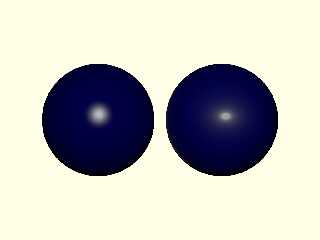|
 |
So, I have puzzled out the important parts of the importance sampling, and want
to move ahead to seeing how it affects a reflection model.
I had already worked out the fundamentals of the Phong model:
https://news.povray.org/povray.binaries.images/thread/%3Cweb.57cb6721f854a3db5e7df57c0%40news.povray.org%3E/?ttop=43851
6&toff=750
https://en.wikipedia.org/wiki/Phong_reflection_model
And so just needed to work out how to put all of that in vector component
separated and daisy-chained functions so I could texture a sphere.
It seems like I've got the basics down, however I'm needing to divide my angle
between the reflection vector and camera vector by 4, otherwise I get a HUGE
phong highlight.
My reflection vector calculation also seems to be sign inverted.
http://cosinekitty.com/raytrace/chapter10_reflection.html
Also, even though I'm doing
function {min (max (Specular (x, y, z), 0), 1)}
I still seem to be veering out of the 0-1 range when my shininess factor (the
phong exponent) goes below 2. Weird.
I would love to get everything ironed out so as to not have to worry about weird
fudge factors, so that when I puzzle out and refine applying the importance
sampling part, I can focus on the real issues and not be chasing ghosts in the
code.
#declare SFn_vdot = function (ax, ay, az, bx, by, bz) {ax*bx + ay*by + az*bz}
#declare RX = function {L_hatX - (2 * SFn_vdot (L_hatX, L_hatY, L_hatZ, x, y,
z)) * x}
#declare RY = function {L_hatY - (2 * SFn_vdot (L_hatX, L_hatY, L_hatZ, x, y,
z)) * y}
#declare RZ = function {L_hatZ - (2 * SFn_vdot (L_hatX, L_hatY, L_hatZ, x, y,
z)) * z}
#declare R_hatX = function {RX (x , y, z) / SFn_vlength (RX (x , y, z), RY (x ,
y, z), RY (x , y, z))}
#declare R_hatY = function {RY (x , y, z) / SFn_vlength (RX (x , y, z), RY (x ,
y, z), RY (x , y, z))}
#declare R_hatZ = function {RZ (x , y, z) / SFn_vlength (RX (x , y, z), RY (x ,
y, z), RY (x , y, z))}
#declare Specular = function {k_s * pow (SFn_vdot (-R_hatX (x, y, z), -R_hatY
(x, y, z), -R_hatZ (x, y, z), V_hatX, V_hatY, V_hatZ)/4, _alpha) * i_s}
The sphere on the left is a isosurface with finish {phong 1}, and the one on the
right is pigmented according to my Phong specular reflectance function.
Post a reply to this message
Attachments:
Download 'importancesampledphongbrdf.png' (68 KB)
Preview of image 'importancesampledphongbrdf.png'

|
 |




![]()